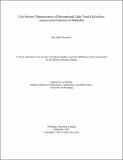Life-history Characteristics of Recreational Lake Trout (Salvelinus namaycush) Fisheries in Manitoba
Metadata
Afficher la notice complèteAuthor
Navarroli, Giulio
Date
2023-10-23Citation
Navarroli, Giulio. Life-history Characteristics of Recreational Lake Trout (Salvelinus namaycush) Fisheries in Manitoba; A Thesis submitted to the Faculty of Graduate Studies in partial fulfillment of the requirements for the Master of Science degree ... in Bioscience, Technology, and Public Policy, University of Winnipeg. Winnipeg, Manitoba, Canada: University of Winnipeg, September 2023. DOI: 10.36939/ir.202310231532.
Abstract
Contemporary data concerning lake trout (Salvelinus namaycush) populations have been lacking in the province of Manitoba for several decades. I compared life history characteristics (age, condition, growth, maturity, and survival) of lake trout from seven lakes in order to assess their present state. Furthermore, lake trout have been observed to have different ecotypes that exhibit different life-history traits and behaviours, therefore lake trout otolith morphology was compared to potentially identify suspected sympatric ecotypes in Clearwater Lake, Manitoba. Summer profundal index netting (SPIN) gillnets were set at varying depths during summer months in 2021 and 2022 to complete this project. Otolith morphology was compared using elliptic Fourier analyses. Length-at-age was back-calculated for lake trout individuals, and growth data was fitted by von Bertalanffy growth curves. Growth curves differed significantly across lakes based on several parameters (L8, K, t0, and w). Northern lakes had the propensity to hold trophy-sized lake trout, while southern lakes did not. Significant otolith morphological differences between suspected lake trout ecotypes within Clearwater Lake. However, it is not possible to ascertain that otolith morphological differences are a result of different ecotypes or differing growth rates. There was a notable scarcity of lake trout in most southern lakes, while northern lake trout populations appear to be healthy. Historical high fishing pressure might be a culprit associated with the poor status of several southern lake trout populations. Fisheries Manitoba should consider using the SPIN program to further evaluate lake trout fisheries in Manitoba.

